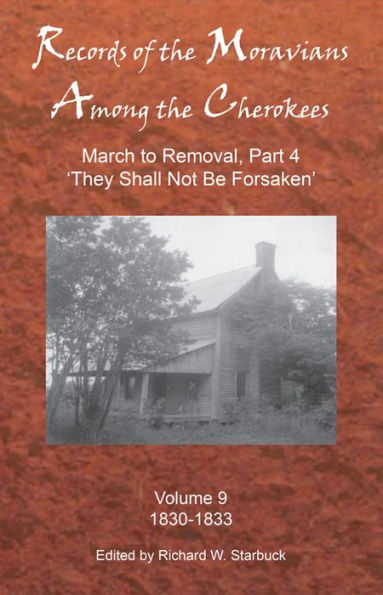Home
Records of the Moravians Among the Cherokees: Volume Nine: March to Removal, Part 4 'They Shall Not Be Forsaken', 1830-1833
Barnes and Noble
Records of the Moravians Among the Cherokees: Volume Nine: March to Removal, Part 4 'They Shall Not Be Forsaken', 1830-1833
Current price: $40.00


Barnes and Noble
Records of the Moravians Among the Cherokees: Volume Nine: March to Removal, Part 4 'They Shall Not Be Forsaken', 1830-1833
Current price: $40.00
Size: OS
Loading Inventory...
*Product information may vary - to confirm product availability, pricing, shipping and return information please contact Barnes and Noble
The collision between the Cherokee Nation and the State of Georgia moves inexorably closer, as chronicled by Moravian Church missionaries in volume 9 of
Records of the Moravians among the Cherokees
covering August 1830-1833. Continuing the subtitle series March to Removal, volume 9 opens with an air of peace and quiet that belies the future. That tranquility is shattered when Georgia orders all white men in the Cherokee Nation to take an oath of allegiance to the state’s laws or leave the country. The new law ushers in a year of upheaval, terror, and imprisonment, as Georgia Guards sweep the land of white laborers, artisans, and especially, as Br. Gottlieb Byhan reports, the “Yankee Missionaries” of the American Board in Boston. The jailing of Samuel Worcester eventually becomes a national cause célèbre before the United States Supreme Court, to no avail. The Moravian missionaries too suffer. First Oochgeelogy, their mission station near New Echota, the Cherokees’ capital, is lost to “renters.” Then on New Year’s Day, 1833, the Moravians’ beloved Springplace, the first mission station in the Cherokee Nation, is overrun by whites who have “won” it through Georgia’s lottery of land sales in the Cherokee Nation. With this loss, the Moravians have no recourse but to seek refuge in Tennessee beyond the reach of Georgia law. Must they abandon their little congregation of Cherokee members? Back home in Salem, North Carolina, church authorities vow: “They shall not be forsaken.”
uses original diaries, minutes, reports, and correspondence in Moravian Archives in North Carolina to provide a first-hand account of daily life among the Cherokees throughout the nineteenth century. Though written by missionaries from their perspective, these records give much insight into Cherokee culture, society, customs, and personalities.
Records of the Moravians among the Cherokees
covering August 1830-1833. Continuing the subtitle series March to Removal, volume 9 opens with an air of peace and quiet that belies the future. That tranquility is shattered when Georgia orders all white men in the Cherokee Nation to take an oath of allegiance to the state’s laws or leave the country. The new law ushers in a year of upheaval, terror, and imprisonment, as Georgia Guards sweep the land of white laborers, artisans, and especially, as Br. Gottlieb Byhan reports, the “Yankee Missionaries” of the American Board in Boston. The jailing of Samuel Worcester eventually becomes a national cause célèbre before the United States Supreme Court, to no avail. The Moravian missionaries too suffer. First Oochgeelogy, their mission station near New Echota, the Cherokees’ capital, is lost to “renters.” Then on New Year’s Day, 1833, the Moravians’ beloved Springplace, the first mission station in the Cherokee Nation, is overrun by whites who have “won” it through Georgia’s lottery of land sales in the Cherokee Nation. With this loss, the Moravians have no recourse but to seek refuge in Tennessee beyond the reach of Georgia law. Must they abandon their little congregation of Cherokee members? Back home in Salem, North Carolina, church authorities vow: “They shall not be forsaken.”
uses original diaries, minutes, reports, and correspondence in Moravian Archives in North Carolina to provide a first-hand account of daily life among the Cherokees throughout the nineteenth century. Though written by missionaries from their perspective, these records give much insight into Cherokee culture, society, customs, and personalities.






